Top Sign Up Form Examples to Boost Your Conversions
A well-designed sign up form is one of the most critical conversion points on any website. It’s the gateway to building your email list, generating leads, and growing your community. But creating a form that captures attention without causing friction requires a strategic approach. This article moves beyond generic advice to provide a deep dive into effective sign up form examples from leading platforms. We will analyze precisely what makes each design successful, from its layout and copy to its user experience flow.
For small business owners, content creators, and marketing professionals, finding the right starting point is key. To kickstart your form design and find inspiration, exploring various 12 Event registration form templates can be incredibly helpful. This resource provides a solid foundation for more specific applications.
In the following sections, we will break down real-world examples from platforms like HubSpot, Jotform, and WPForms. For each example, you’ll find:
- A high-quality screenshot for visual reference.
- Direct links to see the forms in action.
- A strategic analysis of why the form works.
- Actionable takeaways you can apply to your own forms immediately.
This guide is designed to help you stop guessing and start building sign up forms that convert. Let's explore the examples.
1. Jotform
Jotform stands out not as a single sign-up form example, but as an extensive library of inspiration and a powerful creation tool rolled into one. For small business owners, freelancers, and marketers who need to deploy a variety of forms quickly, Jotform offers a massive advantage: a collection of over 200 free, purpose-built sign-up form templates. This repository covers nearly every conceivable use case, from event registrations and email newsletter subscriptions to volunteer applications and course enrollments.
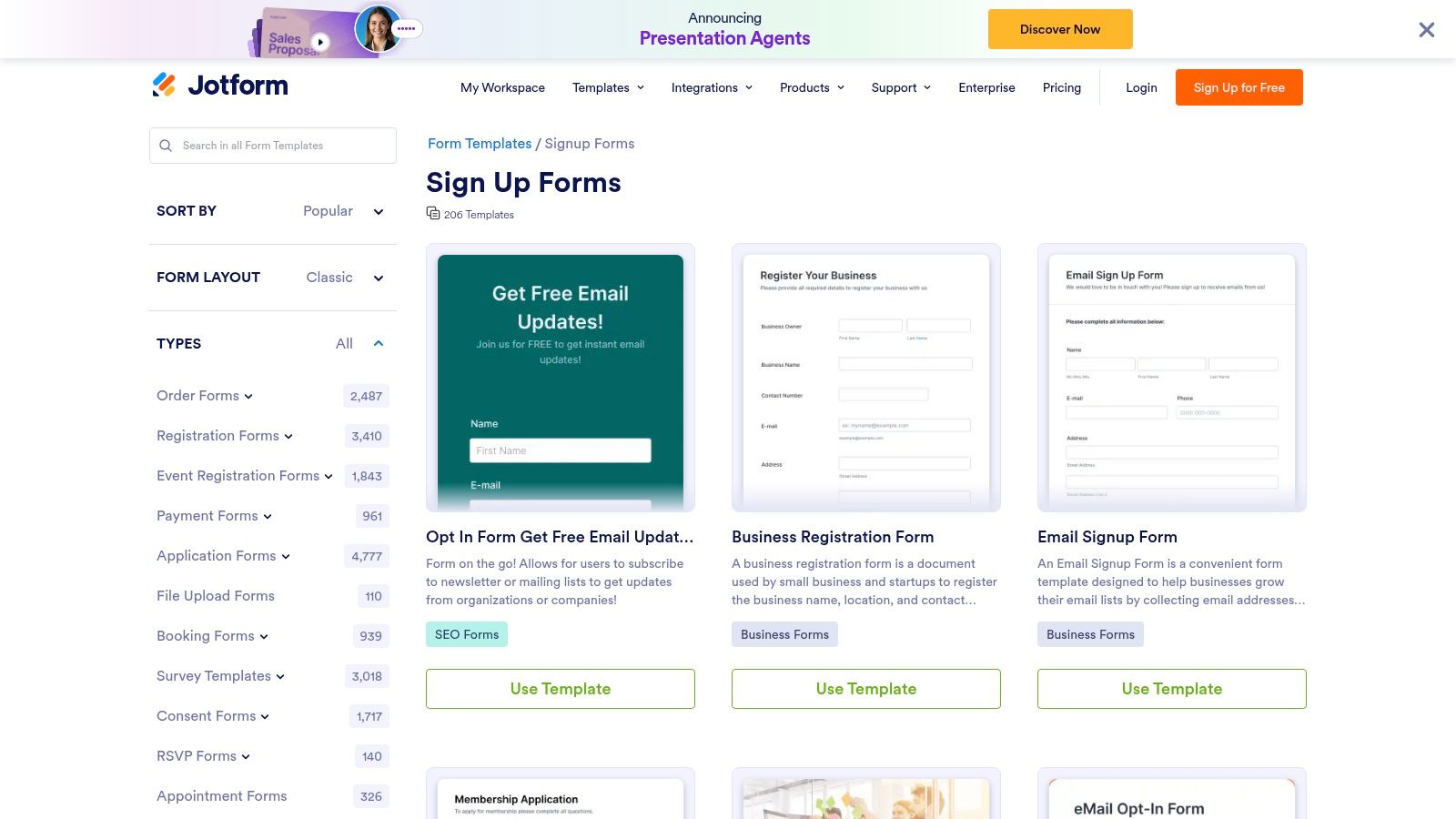
The platform’s core strength lies in its accessibility. The drag-and-drop builder empowers users without any coding knowledge to customize templates or build a form from scratch. This user-friendly interface significantly lowers the barrier to creating professional, mobile-responsive, and secure forms.
Strategic Analysis
What makes Jotform a top-tier resource is its blend of variety and functionality. Instead of just providing static design ideas, it gives you the tools to immediately implement and adapt them. This approach is highly efficient for improving website conversions. By starting with a proven template, you can focus on fine-tuning copy and fields rather than wrestling with design and code. For users seeking to optimize their forms, learning how to improve website conversion rates can provide a deeper strategic framework to apply to Jotform’s flexible tools.
Key Features and Access
| Feature | Details |
|---|---|
| Templates | Over 200 customizable sign-up form templates. |
| Form Builder | No-code, drag-and-drop interface for easy customization. |
| Integrations | Connects with popular apps like PayPal, Stripe, Mailchimp, and Google Sheets. |
| Security | Secure data collection (PCI, GDPR, HIPAA compliance options available). |
| Pricing | A free plan is available with limitations on forms and submissions. Paid plans unlock advanced features and higher limits. |
Actionable Takeaways
- Start with a Template: Don't reinvent the wheel. Browse Jotform's library and find a template that most closely matches your goal. This saves significant time and provides a solid structural foundation.
- Utilize Integrations: Connect your form to your email marketing service or CRM from the start. This automates your workflow and ensures new sign-ups are immediately added to your marketing funnel.
- Customize for Brand Consistency: Use the form builder to adjust colors, fonts, and logos to match your website's branding. A consistent look builds trust and professionalism.
- Leverage the Free Plan: For small projects or testing, the free plan is more than sufficient. Use it to experiment with different sign-up form examples before committing to a paid subscription.
Website: https://www.jotform.com/form-templates/category/signup-form
2. Paperform
Paperform positions itself uniquely by blurring the line between a form builder and a landing page creator. It provides a platform where your sign-up form isn't just an element on a page, but the page itself. This approach is ideal for businesses and creators who want to create immersive, beautifully designed sign-up experiences for event registrations, course enrollments, or detailed newsletter subscriptions without needing a separate landing page tool.
The platform's strength is its free-text interface, which feels more like writing a document than configuring a traditional form. This intuitive design process allows for the creation of highly aesthetic and brand-aligned forms that are both powerful and engaging. With over 47 dedicated sign-up form templates, users have a solid starting point for crafting these unique experiences.
Strategic Analysis
Paperform’s key advantage is its emphasis on design and user experience. Where many tools focus purely on data capture, Paperform helps you create a compelling narrative around the sign-up itself. This is particularly effective for high-value conversions, like paid courses or exclusive memberships, where the initial impression must justify the user's commitment. The ability to embed rich media, customize typography, and structure the form like a webpage makes these sign-up form examples powerful marketing assets.
Key Features and Access
| Feature | Details |
|---|---|
| Hybrid Design | Blends form building with landing page design for a seamless "form-as-a-page" experience. |
| Templates | Over 47 customizable templates for various sign-up needs. |
| Integrations | Extensive connectivity with over 2,000 apps via direct integrations and Zapier. |
| Advanced Logic | Supports conditional logic to create dynamic forms that adapt to user input. |
| Pricing | No free plan is offered, but a 14-day free trial is available to test all features. Paid plans are required for continued use. |
Actionable Takeaways
- Create Immersive Experiences: Use Paperform for sign-ups that require more context, such as workshops or premium content. Build a dedicated page that sells the value proposition before asking for information.
- Match Your Branding Perfectly: Take full advantage of the advanced design features. Adjust fonts, colors, and layouts to ensure your sign-up page is a perfect extension of your brand identity, which builds user trust.
- Leverage Conditional Logic: For complex registrations, use conditional logic to simplify the user's journey. Only show relevant fields based on previous answers to reduce friction and form abandonment.
- Maximize the Free Trial: Plan your test case before starting the 14-day trial. Aim to build, integrate, and test a complete sign-up flow to accurately assess if the platform's unique approach fits your needs.
Website: https://paperform.co/templates/category/signup-forms/
3. WPForms
For users building their digital presence on WordPress, WPForms is an indispensable tool for creating effective sign-up forms. As one of the most popular WordPress form builder plugins, it excels at seamlessly integrating into the WordPress ecosystem. It offers a specialized library of over 20 sign-up form templates designed for specific marketing goals, such as growing an email list, registering users for a webinar, or capturing event sign-ups.
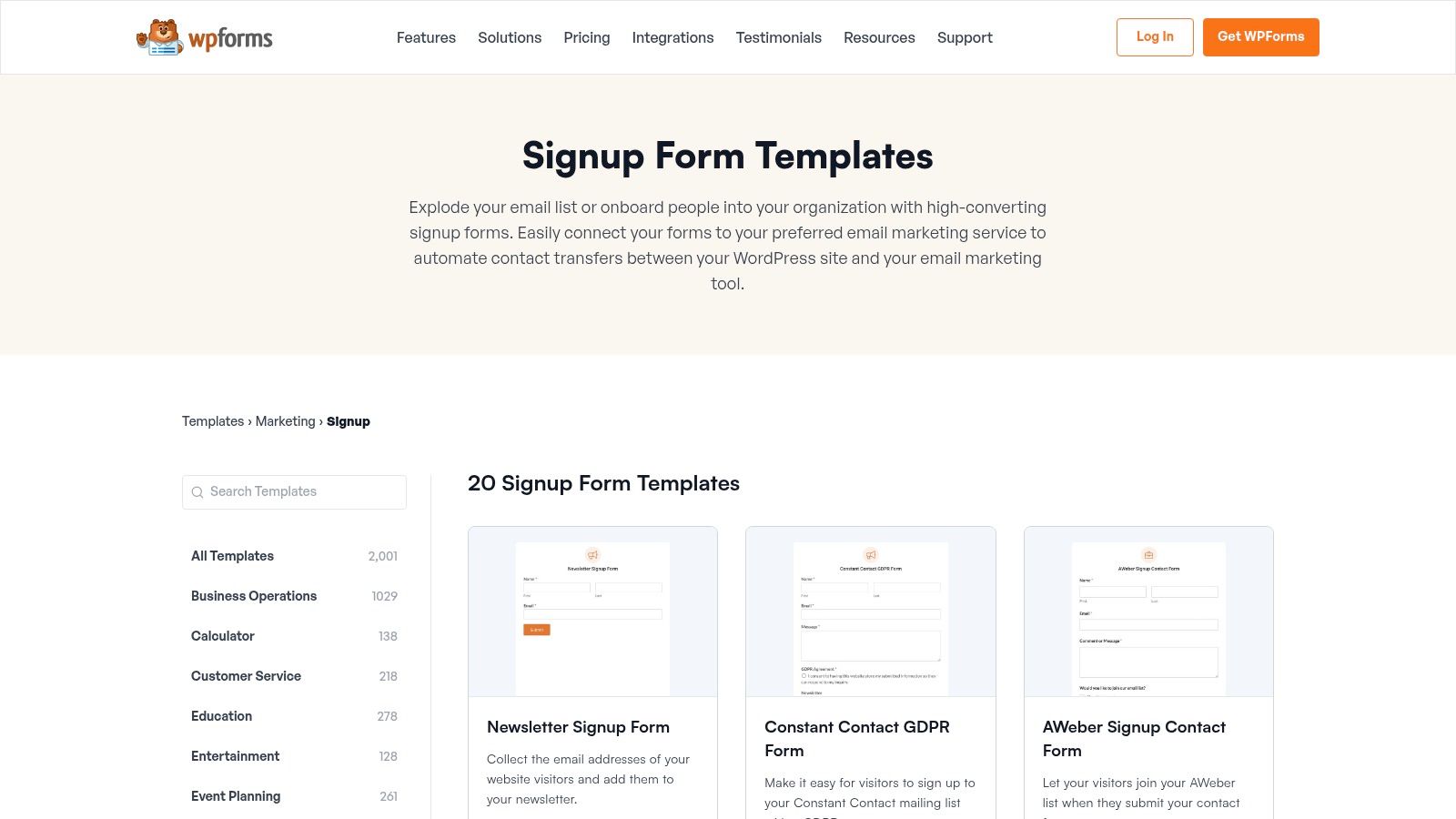
The primary strength of WPForms lies in its beginner-friendly design. The drag-and-drop builder empowers WordPress site owners, even those without technical expertise, to craft and deploy professional forms in minutes. This focus on user experience, combined with its deep integration into the world's most popular CMS, makes it a go-to solution for millions of businesses and creators.
Strategic Analysis
WPForms' strategic advantage is its native WordPress environment. Unlike third-party tools that can sometimes feel disconnected, WPForms operates directly from your dashboard, ensuring a smooth workflow and consistent branding. This makes it incredibly efficient for creating sign-up form examples that not only look good but are also perfectly optimized for your site's performance and design. The form’s placement and design are critical, and applying strong principles can significantly boost submissions; for a deeper dive, exploring these landing page design tips can provide valuable context for maximizing your form's impact.
Key Features and Access
| Feature | Details |
|---|---|
| Templates | Over 20 pre-built templates for marketing and sign-up purposes. |
| Form Builder | Intuitive drag-and-drop interface designed for WordPress users. |
| Integrations | Connects directly with leading email marketing services like Mailchimp, AWeber, and Constant Contact. |
| Spam Protection | Built-in smart CAPTCHA and Honeypot methods to prevent spam submissions. |
| Pricing | A free "Lite" version is available with basic features. Pro plans unlock templates, integrations, and advanced logic. |
Actionable Takeaways
- Choose a Goal-Oriented Template: Start by selecting a template that matches your specific objective, such as the "Newsletter Signup Form" or "Webinar Registration Form," to ensure the right fields are included from the beginning.
- Activate Spam Protection: Immediately enable the anti-spam honeypot or reCAPTCHA feature. This is a simple but crucial step to maintain a clean and high-quality email list.
- Embed Strategically: Use the WPForms block or shortcode to place your form in high-visibility areas like your website's sidebar, footer, or within relevant blog posts to maximize sign-up opportunities.
- Start with the Lite Version: If your needs are simple, the free WPForms Lite plugin is a powerful tool for creating basic contact or newsletter sign-up forms. It allows you to get comfortable with the interface before upgrading.
Website: https://wpforms.com/templates/category/marketing/signup-forms/
4. Visme
Visme takes a design-first approach to sign-up forms, positioning them not just as data capture tools but as powerful pieces of visual communication. Where other builders focus purely on function, Visme excels in creating forms that are visually rich and highly engaging. This makes it an ideal choice for brands, creators, and marketers who want their sign-up process to reflect their aesthetic and captivate their audience from the very first interaction.
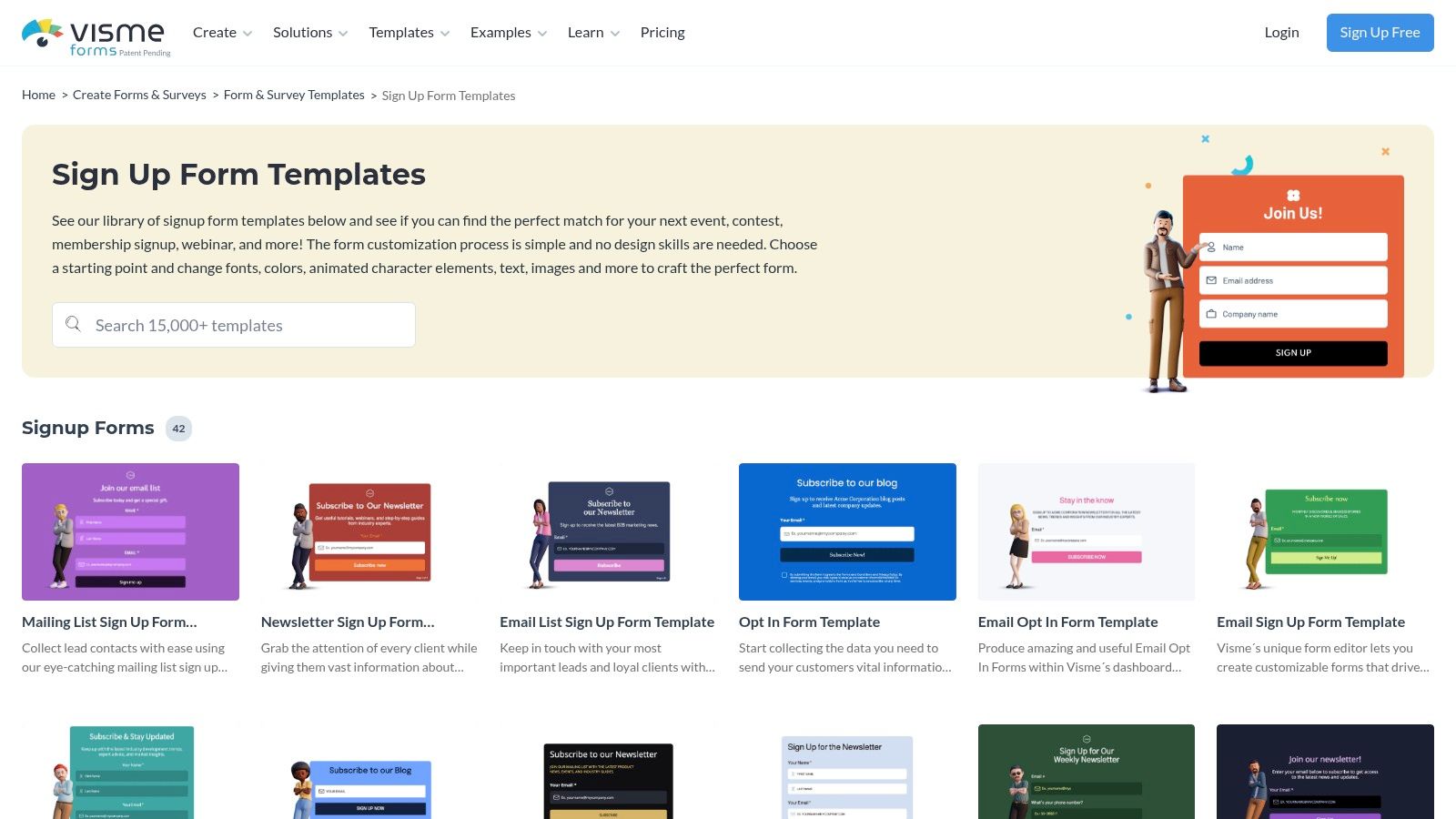
The platform’s core strength is its versatile drag-and-drop editor, which allows for deep customization well beyond basic color and font changes. Users can easily incorporate high-quality graphics, branded elements, and even interactive components directly into their forms. This focus on visual appeal makes Visme’s sign-up form examples a fantastic source of inspiration for anyone looking to break away from standard, uninspired designs.
Strategic Analysis
What sets Visme apart is its ability to treat a sign-up form as a seamless extension of a brand’s visual identity. The platform empowers users to create forms that don't just ask for information but also tell a story and enhance the user experience. By integrating compelling design and interactive elements, a Visme form can significantly reduce friction and abandonment. This strategy is particularly effective for visually-driven industries like creative agencies, e-commerce, and personal branding, where a strong first impression is critical for conversion.
Key Features and Access
| Feature | Details |
|---|---|
| Templates | A wide range of visually appealing and fully customizable sign-up form templates. |
| Form Builder | Intuitive drag-and-drop editor with a focus on design and interactive elements. |
| Interactivity | Add animations, pop-ups, and other interactive features to boost engagement. |
| Analytics | Built-in analytics to track views, starts, and completion rates to optimize performance. |
| Pricing | A free plan is available but includes Visme branding. Paid plans unlock premium templates, features, and remove branding. |
Actionable Takeaways
- Prioritize Visuals: Use Visme to create a sign-up form that is an asset, not an afterthought. Incorporate your brand’s colors, typography, and high-quality imagery to build trust and delight users.
- Leverage Interactivity: Experiment with adding subtle animations or interactive fields to make the form-filling process more dynamic and less of a chore. This can improve completion rates.
- Analyze User Behavior: Pay close attention to the built-in analytics. Identify where users drop off and test different designs or field arrangements to optimize the form’s performance.
- Embed Natively: Visme forms are designed to be embedded seamlessly into your website. Ensure the embedded form’s design complements the surrounding page content for a cohesive user journey.
Website: https://www.visme.co/templates/forms-surveys/signup-forms/
5. Formsite
Formsite carves out a niche by focusing on secure, data-driven sign-up forms that cater to organizations with more complex needs, such as non-profits, educational institutions, and event managers. While it offers a solid range of templates for common use cases like event registrations and volunteer sign-ups, its true strength lies in its robust back-end capabilities. The platform prioritizes secure data collection and processing above all else.
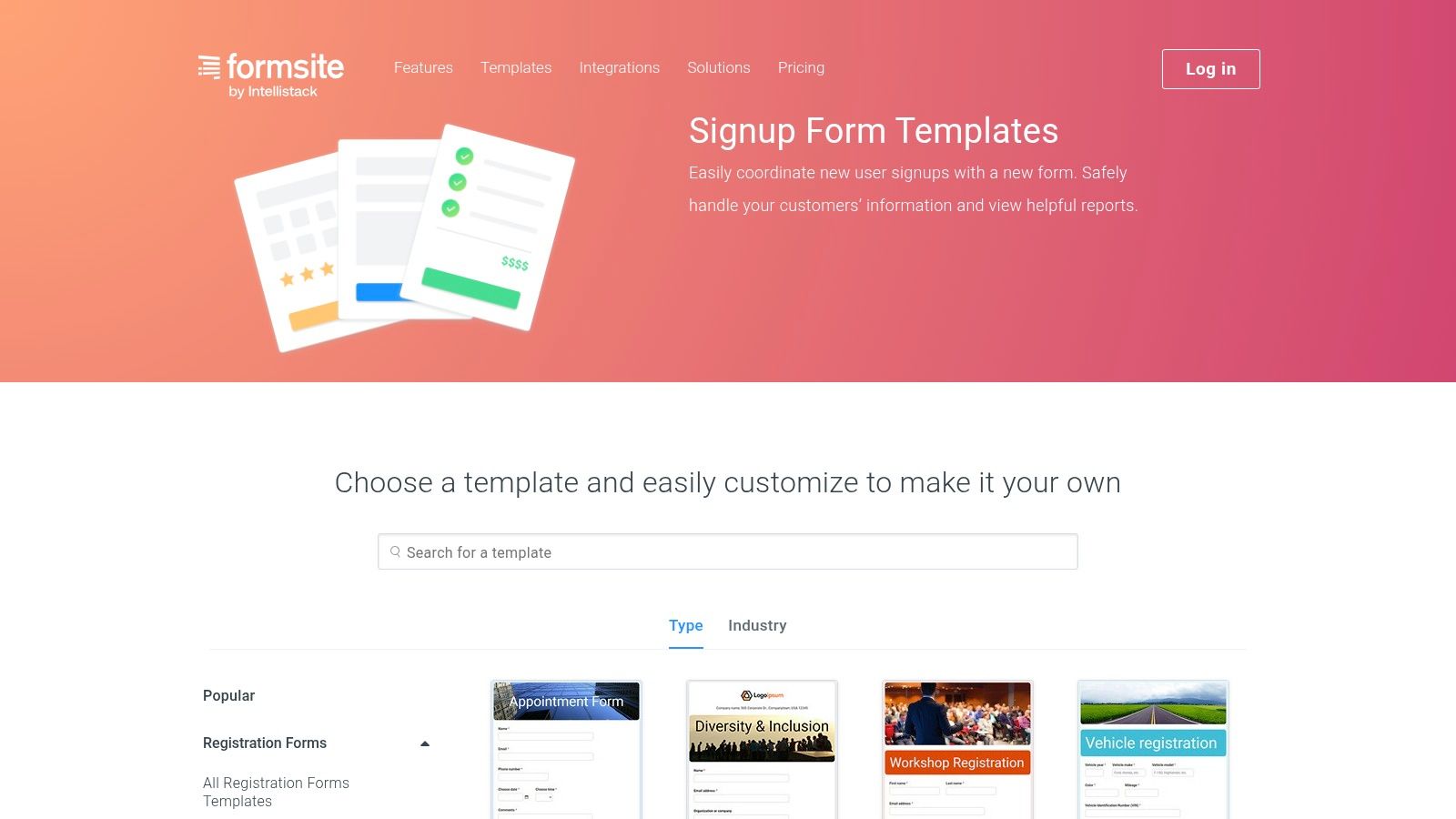
This security-first approach makes Formsite an ideal choice for sign-up forms that handle sensitive information or financial transactions. Its forms are built with SSL encryption, and the platform supports payment integrations, turning a simple sign-up into a secure registration and payment portal.
Strategic Analysis
What sets Formsite apart is its deep functionality for data management and logic. For businesses that need more than a simple name and email field, Formsite allows for the creation of complex forms with conditional logic and calculations. This means your sign-up form can dynamically change based on user input, which is perfect for complex event registrations with multiple tiers, workshops, or add-ons.
This advanced capability positions Formsite as more of a data collection engine than just a form builder. The detailed reporting and data export tools give users powerful ways to analyze and act on the information they collect, making it a valuable tool for data-informed decision-making.
Key Features and Access
| Feature | Details |
|---|---|
| Data Security | SSL encryption is standard for secure data collection. |
| Payment Integrations | Accepts payments through integrations with services like PayPal and Stripe. |
| Complex Logic | Supports conditional rules and calculations within forms. |
| Reporting Tools | Provides tools to create reports, charts, and tables from submission data. |
| Pricing | Offers a limited free trial and several paid tiers. The free plan has significant restrictions on submissions and features. |
Actionable Takeaways
- Prioritize for Security: Choose Formsite when your sign-up form requires collecting payments or sensitive data. Its built-in security features provide peace of mind.
- Embrace Complex Logic: If your registration process has multiple options or variables, use Formsite’s conditional logic to create a streamlined, intuitive user experience that adapts to each user's choices.
- Integrate Payments Directly: For paid events or workshops, use the payment integrations to handle registration and payment in a single, seamless step, reducing friction and improving conversion rates.
- Analyze Submission Data: Go beyond just collecting names. Use the reporting tools to gain insights into your audience, track registration trends, and inform future marketing efforts.
Website: https://www.formsite.com/templates/registration-signup-forms/
6. Template.net
Template.net offers a different approach to sign-up forms, acting as a massive digital library for downloadable and editable templates. It’s an ideal resource for professionals who need a tangible document or a specific file format rather than an embedded web form. The platform provides a broad collection of free and premium sign-up form templates catering to everything from event registrations and memberships to surveys and professional service agreements.
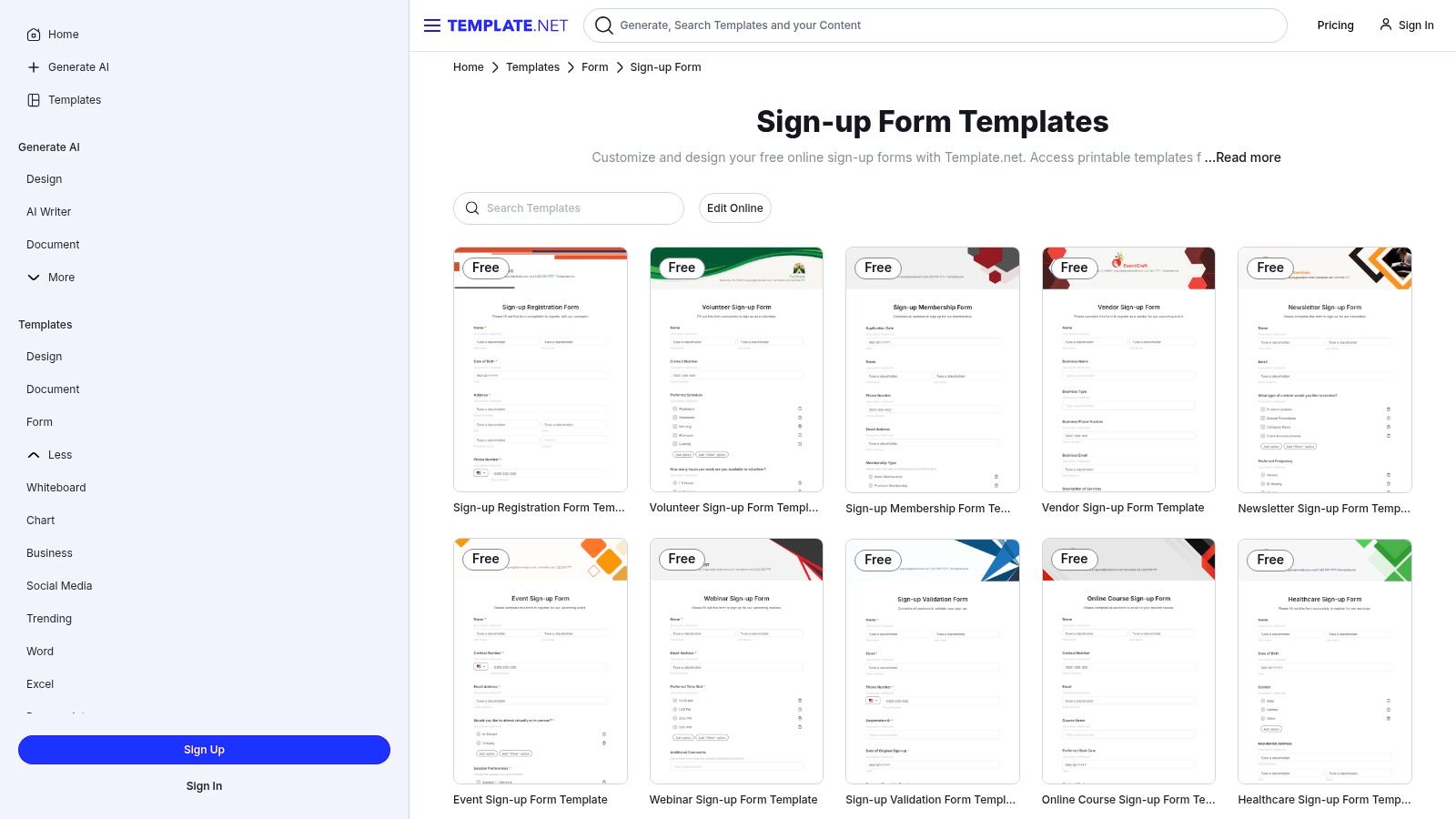
What makes Template.net unique is its focus on format flexibility. Users can find a design they like, edit it directly online with a user-friendly tool, and then download it in various formats like PDF, Word, or Google Docs. This is perfect for situations requiring a physical sign-up sheet or an email attachment, bypassing the need for complex form-building software.
Strategic Analysis
Template.net’s strength lies in its speed and simplicity for offline or document-based needs. While dedicated builders like Jotform focus on web integration and data automation, Template.net excels at providing professionally designed, ready-to-print or shareable files. This makes it one of the more versatile sources for sign up form examples that serve both digital and physical worlds. The strategy here is not about conversion rate optimization through A/B testing, but about efficiency and professional presentation for direct, one-on-one interactions.
Key Features and Access
| Feature | Details |
|---|---|
| Templates | Wide range of editable templates for diverse industries and purposes, including events, memberships, and more. |
| Editing Tools | Simple online editor for quick customization before downloading. |
| Download Formats | Options to download forms in multiple formats like PDF, Word, Pages, and Google Docs. |
| Library Updates | The template library is regularly updated with new designs and layouts. |
| Pricing | A large selection of free templates is available. A premium subscription is required for access to the full library and advanced features. |
Actionable Takeaways
- Identify Your Use Case: Use Template.net when you need a printable form for an event check-in desk, a document to email to a new client, or a standardized form for internal team sign-ups.
- Utilize the Online Editor: Before downloading, use the built-in editor to add your logo, change text, and adjust colors to match your brand identity for a polished, professional look.
- Choose the Right Format: Select the best file format for your needs. A PDF is great for non-editable distribution, while a Word or Google Doc file allows the recipient to fill it out digitally.
- Explore Free Options First: The free template selection is extensive and covers many common scenarios. Browse these first to see if they meet your needs before considering a premium subscription.
Website: https://www.template.net/forms/sign-up
7. HubSpot
HubSpot excels by integrating sign-up forms directly into a comprehensive marketing and sales ecosystem. Rather than just being a standalone tool, HubSpot's form builder is a gateway to its powerful, free CRM. This makes it an ideal choice for businesses focused on turning new sign-ups into managed leads, tracking their journey, and nurturing them through the sales funnel. It provides a suite of registration form templates and tools to create custom forms that are inherently data-driven.
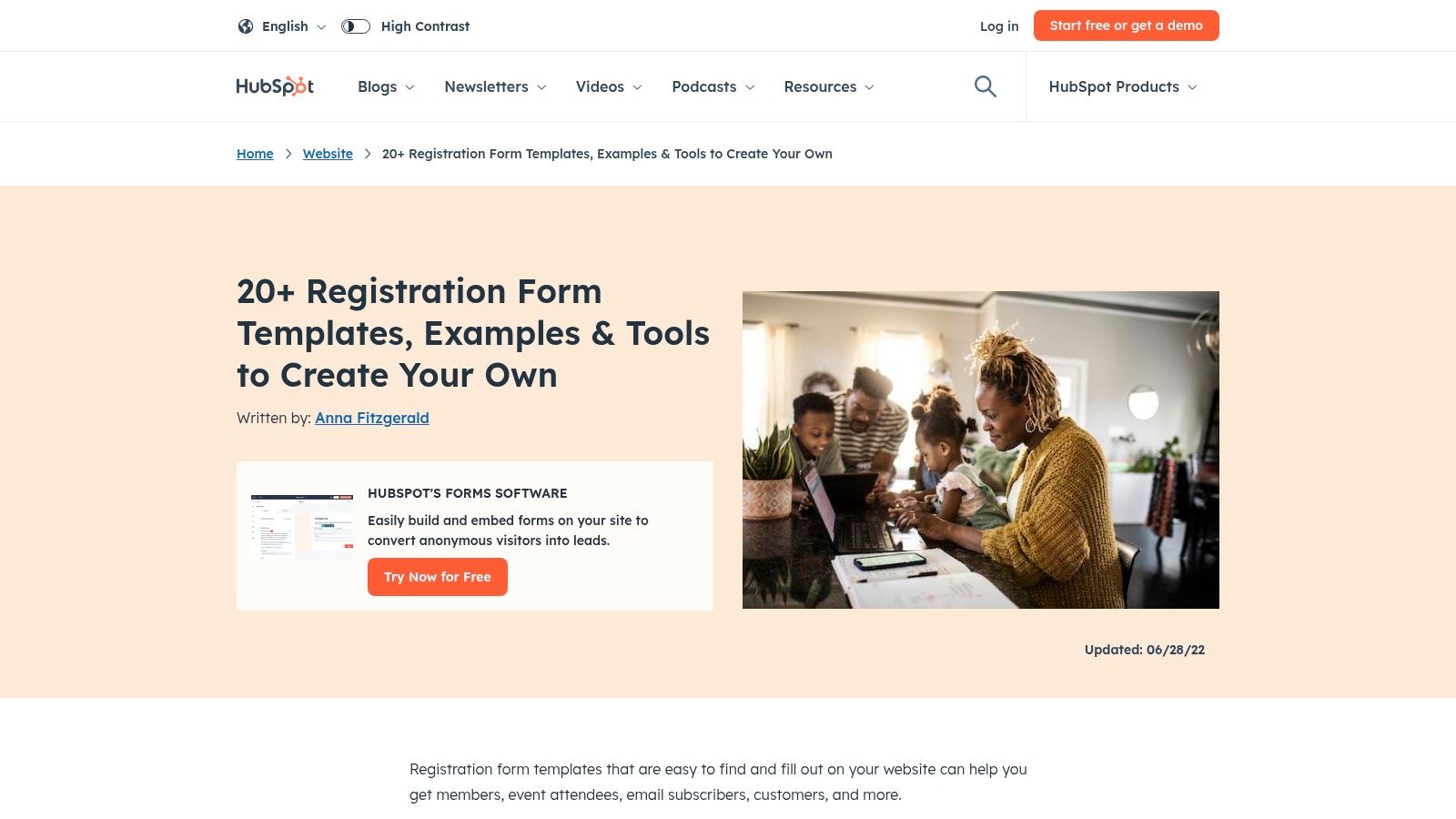
The platform’s major advantage is its seamless, all-in-one nature. With a user-friendly drag-and-drop builder, marketers and business owners can quickly create and deploy various form types, including pop-ups, embedded forms, and standalone pages. Every submission is automatically logged in the CRM, providing immediate context and history for each contact.
Strategic Analysis
The strategic genius of HubSpot's approach is its focus on the post-submission workflow. While many tools focus solely on form design, HubSpot treats the form as the critical starting point for a customer relationship. This makes it one of the best sign up form examples for businesses prioritizing lead management and conversion analytics. The data from each form enriches a contact's profile, enabling personalized follow-ups and segmentation. For those looking to maximize their efforts, understanding different approaches can be highly beneficial; you can explore powerful lead generation campaign examples to see how these forms fit into a larger strategy.
Key Features and Access
| Feature | Details |
|---|---|
| CRM Integration | Every form submission automatically creates or updates a contact record in the free HubSpot CRM. |
| Form Builder | Intuitive drag-and-drop interface with customizable templates. |
| Form Types | Supports embedded forms, standalone pages, pop-up boxes, slide-in banners, and dropdown banners. |
| Analytics | Built-in reporting tools to track views, conversion rates, and submissions over time. |
| Pricing | A robust free plan includes the form builder and CRM. Paid Marketing Hub plans unlock advanced features like smart forms and automation. |
Actionable Takeaways
- Connect the Dots: Use HubSpot if your primary goal is to not just collect leads, but to actively manage and nurture them. The free CRM is the platform's killer feature.
- Start with a Goal: Before building, decide the form's purpose (e.g., newsletter subscription, ebook download). This will dictate the fields you need and the follow-up action in the CRM.
- Use Different Form Types: Test which form type converts best for your audience. An embedded form on a blog post might work for subscriptions, while a pop-up could be better for a time-sensitive offer.
- Analyze Performance: Regularly check the analytics dashboard for your forms. Identify which pages or offers generate the most sign-ups and optimize the underperforming ones.
Website: https://blog.hubspot.com/website/registration-form-template
Sign-Up Form Tool Features Comparison
| Platform | 🔄 Implementation Complexity | 💡 Resource Requirements | 📊 Expected Outcomes | 💡 Ideal Use Cases | ⭐ Key Advantages |
|---|---|---|---|---|---|
| Jotform | Low - drag-and-drop, no coding needed | Moderate - free plan; some features paid | Reliable, secure data collection | Event registrations, email subscriptions | Wide template variety; easy customization; secure |
| Paperform | Medium - advanced design and logic | Moderate to high - no free plan | High-quality, brand-aligned forms | Complex forms with payments and dynamic logic | Visually appealing; extensive integrations; payment support |
| WPForms | Low - WordPress plugin, drag-and-drop | Moderate - requires WordPress site | Mobile-responsive, spam-protected | WordPress sites needing quick setup | Beginner-friendly; seamless WordPress integration; regular updates |
| Visme | Medium - drag-and-drop with interactive elements | Moderate - free version includes branding | Engaging, multimedia-rich forms | Design-focused forms with interactivity | Strong design tools; analytics; multimedia support |
| Formsite | Medium - supports complex logic | Moderate - free limited, paid tiers | Secure data collection, detailed reports | Secure registrations, payment-enabled forms | Emphasis on security; payment options; advanced logic |
| Template.net | Low - online editing or download | Low - free and premium templates available | Fast, simple form creation | Quick form solutions without software | Broad template range; easy offline editing; no special software |
| HubSpot | Medium - drag-and-drop with CRM integration | High - best value with HubSpot CRM | Efficient lead management, analytics | Marketing and sales form automation | CRM integration; analytics; multi-type form support |
Final Thoughts
We’ve journeyed through a diverse landscape of sign up form examples, dissecting what makes each a powerful tool for converting visitors into subscribers, leads, and customers. From the versatile logic of Jotform and Paperform to the seamless WordPress integration of WPForms, the path to a high-performing form is paved with strategic choices, not just aesthetic preferences.
The key takeaway is this: an effective sign up form is never just a collection of fields. It's a critical touchpoint in the user journey, a direct conversation with your audience. The best examples we've explored demonstrate a deep understanding of user psychology, minimizing friction while maximizing clarity and value.
Key Principles to Carry Forward
As you start designing your own forms, remember these core principles distilled from our analysis:
- Clarity Over Clutter: Every field, word, and design element must serve a purpose. If it doesn't help the user or provide you with essential data, remove it. A clean, single-column layout is almost always the winning choice.
- Value Proposition is King: Your audience needs a compelling reason to share their information. Clearly state the benefit they will receive, whether it's an exclusive discount, a valuable newsletter, or access to a powerful tool.
- Build Trust Instantly: Use social proof like testimonials or user counts, include privacy policy links, and use secure-looking design elements. Trust is the currency of conversion.
Your Actionable Next Steps
Translating inspiration into implementation is your next crucial move. Here’s a simple roadmap to get you started:
- Define Your Goal: What is the single most important action you want a user to take? Is it to join a newsletter, book a consultation, or register for an event? Your goal dictates your form's design.
- Map the User Context: Where will this form live? A landing page requires a different approach than a pop-up triggered by exit intent. Match the form's intrusiveness and complexity to the user's mindset at that moment.
- Choose Your Tool Wisely: Review the tools we've covered. If you're a WordPress user, WPForms is a natural fit. For complex, multi-step registrations, a tool like Formsite or Jotform excels. For visually-driven lead magnets, Visme offers unique advantages. Select the platform that best aligns with your technical skills and strategic goals.
- Draft, Test, and Iterate: Your first version is never your last. Launch your form and immediately start tracking its performance. A/B test your headline, your call-to-action button color, or the number of fields to continuously optimize your sign-up rate.
The world of sign up form examples is rich with innovation. By applying these strategic insights and focusing relentlessly on the user experience, you can transform a simple form from a passive data collector into your most effective growth engine.
Now that you have the perfect sign up form, where will you put it? Linkero helps you create a stunning, high-converting link-in-bio page where you can embed your new form, showcase your best content, and direct your audience exactly where you want them to go. Consolidate your online presence and make every click count with a powerful micro-landing page from Linkero.


